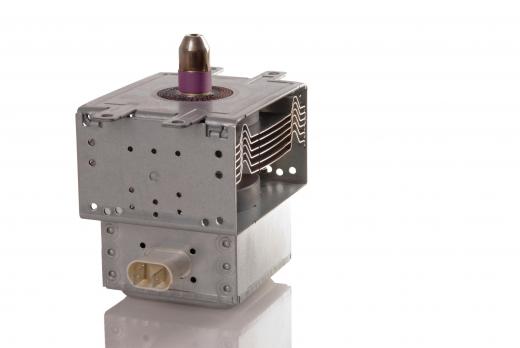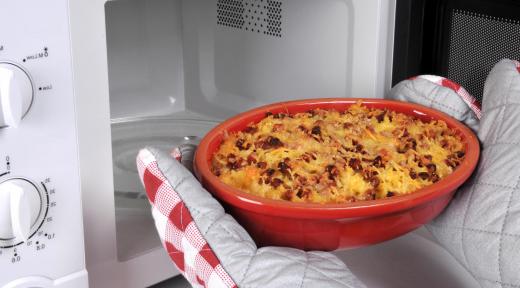What is Microwave Radiation?
Microwaves are electromagnetic rays with a frequency range of 0.3 GHz to 300 Ghz. They are found between the radio waves and the infrared waves in the electromagnetic spectrum. Microwave radiation is the radiating wave movement in which microwave energy travels.
This type of energy takes a straight line path. Like all electromagnetic waves, they do not require a medium to travel through. They can pass through non-metal materials like plastic and glass, but get reflected off metal surfaces. Microwaves are absorbed by foods and other materials with high water content, and produce heat. This is the operational principle on which microwave kitchen appliances work.

A microwave oven consists of a high voltage transformer, an electron tube called magnetron, a wave guide fan, and a cooking chamber. The transformer passes electric energy to the magnetron, which converts this electric energy into microwave radiation. The radiation is reflected in the cooking chamber and absorbed by the food.
As a result of the microwave absorption, the water molecules in the food begin to vibrate. This molecular movement produces heat, which cooks the food. Foods that have higher concentrations of water molecules cook faster. In thicker foods, the outer part is cooked by the microwaves and the inner part is cooked by conduction of heat from the heated outer part.

Concerns about microwaves turning food radioactive are baseless. The "radiation" refers to the way in which microwaves move, not radioactivity. Microwaves are of a non-ionizing character, which means that they do not have the energy to cause chemical changes in substances as would happen in the case of radioactivity.
The principle danger of microwaves is that body tissue can be affected in the same way that food is. They can cause burns, eye cataracts, and other injuries. It, however, would take high levels of energy for this to happen. The levels of radiation in kitchen appliances are fortunately very low.
Microwave radiation also stops as soon as an appliance is turned off. This means that the dangers of standing in front of the microwave oven are rather negligible. At the same time, it is important for cooks to take sensible precautions.

Before buying a microwave kitchen appliance, a shopper should make sure that it meets industry approved safety standards. He should read and follow the device's instructions before using it. Only bowls and vessels specifically designed for microwave oven use should be placed inside. People should also avoid heating water or other liquids in the oven, at least not for long periods. The oven door should also be kept shut when it is in operation.
AS FEATURED ON:
AS FEATURED ON:















Discussion Comments
We recently bought a house and on the backyard we have a shed that is rusted on the corner and on the roof. I used Trifield meter for low frequency and Extech meter for high frequency to measure the amount of microwave radiation on the backyard. When I came closer to the rusted part of the shed, both meters went completely off, showing that there is a microwave radiation coming from the rusted part of the shed. How could this be possible? Please help us solve this mystery.
Do you know if microwave leak detectors like Micro-Chex are good or just a waste of money?
when the microwave oven is turned on at the power point but not in use, does it emit radiation? If so, is it best to turn the oven off at the power point when not in use?
anon79537: I heat drinks (coffee, tea, milk, soup) in the microwave all the time, and have only had to be careful not to overheat drinks with milk, as milk tends to boil over if it gets past the boiling point. I think because drinks like the above are not only water, but have particles suspended in the water, that's what makes the difference and makes it perfectly safe to do.
And I don't know that it's "wrong" to have that dish of water in the micro along with your food; it probably *does* make it more moist (although, you can keep your food from losing moisture in the micro simply by putting it in a dish and covering it with plastic wrap before heating). But keep in mind what Alchemy posted, and take precautions with that dish of water, so as not to disturb it and cause the eruption s/he talked about.
@ Anon79537 - There is a very good reason not to heat water in the microwave. Microwave’s can cause water to heat beyond its boiling point. This happens when there is nowhere for the bubbles to form. When water is boiled bubbles form; expelling some water as steam, and maintaining the temperature around 212 degrees Fahrenheit.
If water is heated in the microwave in a container with very smooth sides (like Pyrex type glass) then there will be nowhere for the bubbles to form. This will cause the hot water to store the energy from the microwave rather than releasing it in the form of thermal energy (i.e. in the form of steam). When the water is subsequently removed from the microwave it has a lot of stored energy. All it will take is the container bumping the side of the microwave, or a quick shake, and air will be introduced to the water causing all of that stored energy to be instantly ejected from the container. The water will shoot out in a steaming, boiling eruption that can cause severe burns to the arms and face.
If you are going to heat water in the microwave, place something in the water to diffuse the energy. This can be a wooden stirrer, a tea bag, etc. Water should also be left to sit in the microwave with the door open for a minute so that it has time to cool a little.
Re the last paragraph about not heating water in the microwave. We often heat up cold cups of liquid to re-heat or we re-heat our left over soups in big soup cups. Is there a reason not to?
We started using a small dish of water when we heated up our breads or pizzas. Lately, we just left the dish of water in thinking it would make all our foods more moist. Is this wrong to do?
Post your comments